为什么作业成本法在中国的银行应用失败_[文献翻译]
- 格式:docx
- 大小:21.25 KB
- 文档页数:12
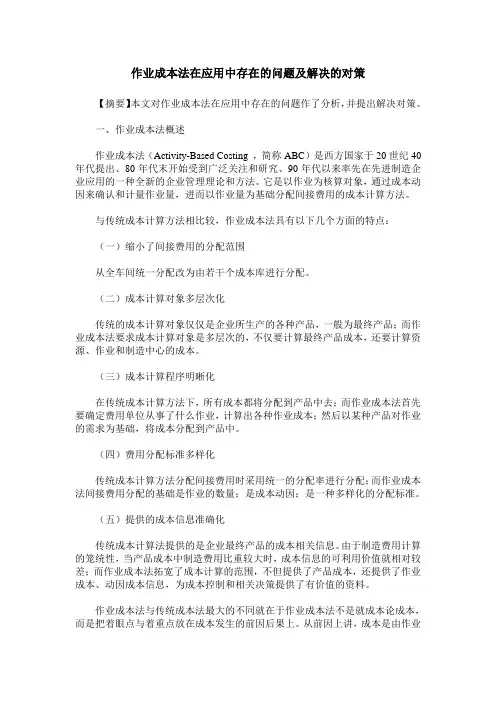
作业成本法在应用中存在的问题及解决的对策【摘要】本文对作业成本法在应用中存在的问题作了分析,并提出解决对策。
一、作业成本法概述作业成本法(Activity-Based Costing ,简称ABC)是西方国家于20世纪40年代提出、80年代末开始受到广泛关注和研究、90年代以来率先在先进制造企业应用的一种全新的企业管理理论和方法。
它是以作业为核算对象,通过成本动因来确认和计量作业量,进而以作业量为基础分配间接费用的成本计算方法。
与传统成本计算方法相比较,作业成本法具有以下几个方面的特点:(一)缩小了间接费用的分配范围从全车间统一分配改为由若干个成本库进行分配。
(二)成本计算对象多层次化传统的成本计算对象仅仅是企业所生产的各种产品,一般为最终产品;而作业成本法要求成本计算对象是多层次的,不仅要计算最终产品成本,还要计算资源、作业和制造中心的成本。
(三)成本计算程序明晰化在传统成本计算方法下,所有成本都将分配到产品中去;而作业成本法首先要确定费用单位从事了什么作业,计算出各种作业成本;然后以某种产品对作业的需求为基础,将成本分配到产品中。
(四)费用分配标准多样化传统成本计算方法分配间接费用时采用统一的分配率进行分配;而作业成本法间接费用分配的基础是作业的数量;是成本动因;是一种多样化的分配标准。
(五)提供的成本信息准确化传统成本计算法提供的是企业最终产品的成本相关信息。
由于制造费用计算的笼统性,当产品成本中制造费用比重较大时,成本信息的可利用价值就相对较差;而作业成本法拓宽了成本计算的范围,不但提供了产品成本,还提供了作业成本、动因成本信息,为成本控制和相关决策提供了有价值的资料。
作业成本法与传统成本法最大的不同就在于作业成本法不是就成本论成本,而是把着眼点与着重点放在成本发生的前因后果上。
从前因上讲,成本是由作业引起的,对成本的分析应该是对价值链的分析,而价值链贯穿于企业经营的所有环节,所以成本分析首先从市场需求和产品设计环节开始;从后果上讲,要搞清作业的完成实际耗费了多少资源,这些资源是如何实现价值链转移的,最终向客户(即市场)转移了多少价值、收取了多少价值,成本分析才算结束。
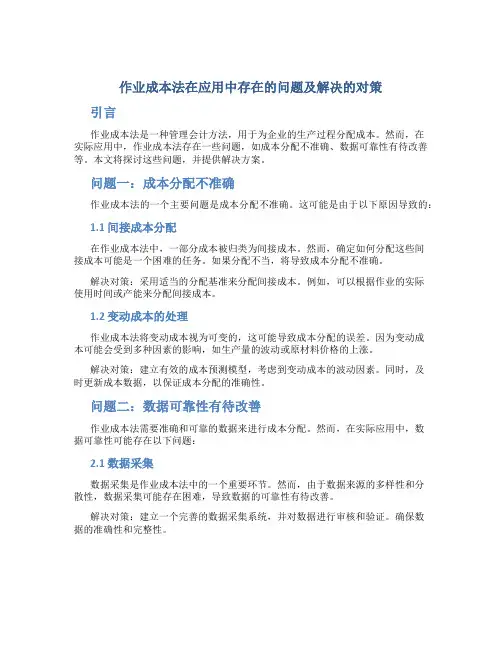
作业成本法在应用中存在的问题及解决的对策引言作业成本法是一种管理会计方法,用于为企业的生产过程分配成本。
然而,在实际应用中,作业成本法存在一些问题,如成本分配不准确、数据可靠性有待改善等。
本文将探讨这些问题,并提供解决方案。
问题一:成本分配不准确作业成本法的一个主要问题是成本分配不准确。
这可能是由于以下原因导致的:1.1 间接成本分配在作业成本法中,一部分成本被归类为间接成本。
然而,确定如何分配这些间接成本可能是一个困难的任务。
如果分配不当,将导致成本分配不准确。
解决对策:采用适当的分配基准来分配间接成本。
例如,可以根据作业的实际使用时间或产能来分配间接成本。
1.2 变动成本的处理作业成本法将变动成本视为可变的,这可能导致成本分配的误差。
因为变动成本可能会受到多种因素的影响,如生产量的波动或原材料价格的上涨。
解决对策:建立有效的成本预测模型,考虑到变动成本的波动因素。
同时,及时更新成本数据,以保证成本分配的准确性。
问题二:数据可靠性有待改善作业成本法需要准确和可靠的数据来进行成本分配。
然而,在实际应用中,数据可靠性可能存在以下问题:2.1 数据采集数据采集是作业成本法中的一个重要环节。
然而,由于数据来源的多样性和分散性,数据采集可能存在困难,导致数据的可靠性有待改善。
解决对策:建立一个完善的数据采集系统,并对数据进行审核和验证。
确保数据的准确性和完整性。
2.2 数据处理数据处理是成本分配的关键步骤之一。
然而,在实际应用中,数据处理可能存在错误或漏洞,导致成本分配不准确。
解决对策:建立一个严格的数据处理流程,并对数据进行验证和校正。
同时,使用自动化工具来处理数据,减少人为错误的发生。
问题三:时效性不足作业成本法要求及时获得成本数据,并进行相应的成本分配。
然而,在实际应用中,由于数据收集和处理的复杂性,时效性可能存在不足的情况。
解决对策:建立一个快速反应的数据收集和处理系统,确保成本数据的及时性。
同时,加强与其他部门的沟通和协作,以提高数据获取的效率。
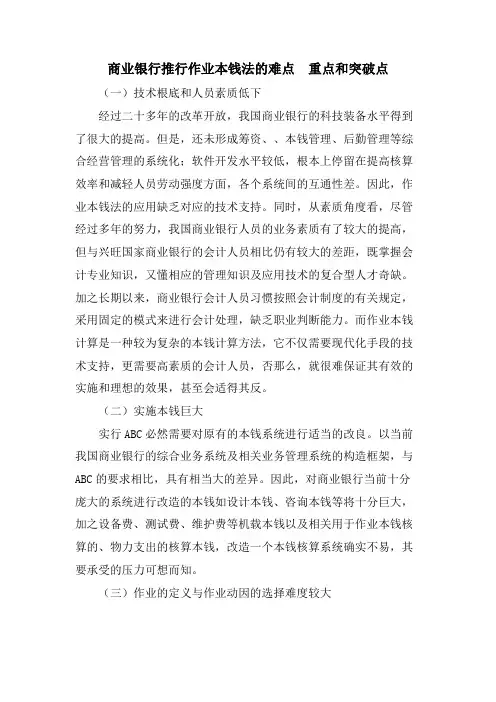
商业银行推行作业本钱法的难点重点和突破点(一)技术根底和人员素质低下经过二十多年的改革开放,我国商业银行的科技装备水平得到了很大的提高。
但是,还未形成筹资、、本钱管理、后勤管理等综合经营管理的系统化;软件开发水平较低,根本上停留在提高核算效率和减轻人员劳动强度方面,各个系统间的互通性差。
因此,作业本钱法的应用缺乏对应的技术支持。
同时,从素质角度看,尽管经过多年的努力,我国商业银行人员的业务素质有了较大的提高,但与兴旺国家商业银行的会计人员相比仍有较大的差距,既掌握会计专业知识,又懂相应的管理知识及应用技术的复合型人才奇缺。
加之长期以来,商业银行会计人员习惯按照会计制度的有关规定,采用固定的模式来进行会计处理,缺乏职业判断能力。
而作业本钱计算是一种较为复杂的本钱计算方法,它不仅需要现代化手段的技术支持,更需要高素质的会计人员,否那么,就很难保证其有效的实施和理想的效果,甚至会适得其反。
(二)实施本钱巨大实行ABC必然需要对原有的本钱系统进行适当的改良。
以当前我国商业银行的综合业务系统及相关业务管理系统的构造框架,与ABC的要求相比,具有相当大的差异。
因此,对商业银行当前十分庞大的系统进行改造的本钱如设计本钱、咨询本钱等将十分巨大,加之设备费、测试费、维护费等机载本钱以及相关用于作业本钱核算的、物力支出的核算本钱,改造一个本钱核算系统确实不易,其要承受的压力可想而知。
(三)作业的定义与作业动因的选择难度较大在商业银行运用ABC,目的是更全面、更合理地将商业银行所消耗的资源分配到消耗这些资源的作业上。
而商业银行的作业是多种多样的,特别是随着金融管制的放松,混业经营趋势的加剧,其作业种类将更加纷繁。
因而对我国商业银行来说,在作业的定义划分、本钱动因的选择是否合理,是影响ABC得以正确运用的关键。
然而,由于经验与技术问题,也由于“代理人”问题,我国商业银行在作业的划分、本钱动因的选择上难免会带有主观性,从而易导致本钱的不真实。
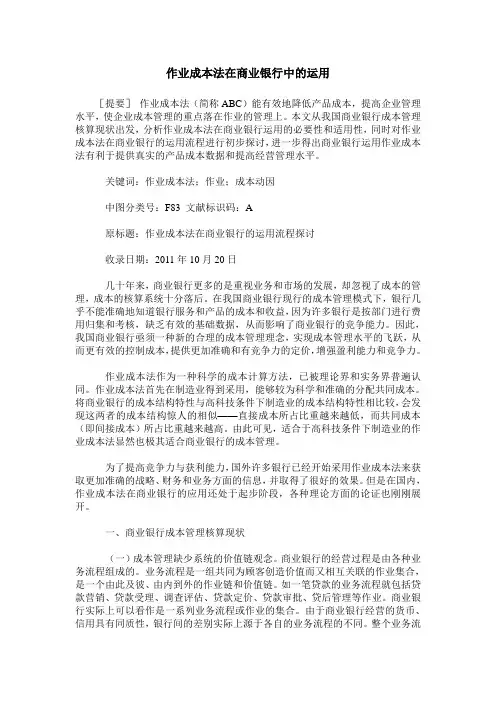
作业成本法在商业银行中的运用[提要]作业成本法(简称ABC)能有效地降低产品成本,提高企业管理水平,使企业成本管理的重点落在作业的管理上。
本文从我国商业银行成本管理核算现状出发,分析作业成本法在商业银行运用的必要性和适用性,同时对作业成本法在商业银行的运用流程进行初步探讨,进一步得出商业银行运用作业成本法有利于提供真实的产品成本数据和提高经营管理水平。
关键词:作业成本法;作业;成本动因中图分类号:F83 文献标识码:A原标题:作业成本法在商业银行的运用流程探讨收录日期:2011年10月20日几十年来,商业银行更多的是重视业务和市场的发展,却忽视了成本的管理,成本的核算系统十分落后。
在我国商业银行现行的成本管理模式下,银行几乎不能准确地知道银行服务和产品的成本和收益,因为许多银行是按部门进行费用归集和考核,缺乏有效的基础数据,从而影响了商业银行的竞争能力。
因此,我国商业银行亟须一种新的合理的成本管理理念,实现成本管理水平的飞跃,从而更有效的控制成本,提供更加准确和有竞争力的定价,增强盈利能力和竞争力。
作业成本法作为一种科学的成本计算方法,已被理论界和实务界普遍认同。
作业成本法首先在制造业得到采用,能够较为科学和准确的分配共同成本。
将商业银行的成本结构特性与高科技条件下制造业的成本结构特性相比较,会发现这两者的成本结构惊人的相似——直接成本所占比重越来越低,而共同成本(即间接成本)所占比重越来越高。
由此可见,适合于高科技条件下制造业的作业成本法显然也极其适合商业银行的成本管理。
为了提高竞争力与获利能力,国外许多银行已经开始采用作业成本法来获取更加准确的战略、财务和业务方面的信息,并取得了很好的效果。
但是在国内,作业成本法在商业银行的应用还处于起步阶段,各种理论方面的论证也刚刚展开。
一、商业银行成本管理核算现状(一)成本管理缺少系统的价值链观念。
商业银行的经营过程是由各种业务流程组成的。
业务流程是一组共同为顾客创造价值而又相互关联的作业集合,是一个由此及彼、由内到外的作业链和价值链。
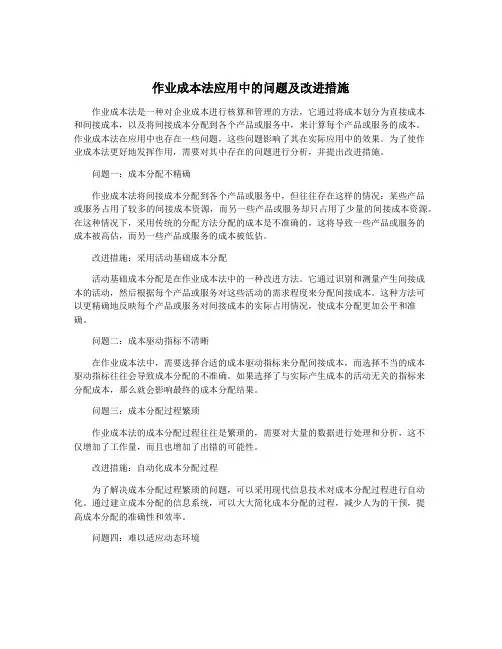
作业成本法应用中的问题及改进措施作业成本法是一种对企业成本进行核算和管理的方法,它通过将成本划分为直接成本和间接成本,以及将间接成本分配到各个产品或服务中,来计算每个产品或服务的成本。
作业成本法在应用中也存在一些问题,这些问题影响了其在实际应用中的效果。
为了使作业成本法更好地发挥作用,需要对其中存在的问题进行分析,并提出改进措施。
问题一:成本分配不精确作业成本法将间接成本分配到各个产品或服务中,但往往存在这样的情况:某些产品或服务占用了较多的间接成本资源,而另一些产品或服务却只占用了少量的间接成本资源。
在这种情况下,采用传统的分配方法分配的成本是不准确的,这将导致一些产品或服务的成本被高估,而另一些产品或服务的成本被低估。
改进措施:采用活动基础成本分配活动基础成本分配是在作业成本法中的一种改进方法。
它通过识别和测量产生间接成本的活动,然后根据每个产品或服务对这些活动的需求程度来分配间接成本。
这种方法可以更精确地反映每个产品或服务对间接成本的实际占用情况,使成本分配更加公平和准确。
问题二:成本驱动指标不清晰在作业成本法中,需要选择合适的成本驱动指标来分配间接成本,而选择不当的成本驱动指标往往会导致成本分配的不准确。
如果选择了与实际产生成本的活动无关的指标来分配成本,那么就会影响最终的成本分配结果。
问题三:成本分配过程繁琐作业成本法的成本分配过程往往是繁琐的,需要对大量的数据进行处理和分析,这不仅增加了工作量,而且也增加了出错的可能性。
改进措施:自动化成本分配过程为了解决成本分配过程繁琐的问题,可以采用现代信息技术对成本分配过程进行自动化。
通过建立成本分配的信息系统,可以大大简化成本分配的过程,减少人为的干预,提高成本分配的准确性和效率。
问题四:难以适应动态环境作业成本法往往是基于固定的成本结构和活动模式进行成本分配的,而在实际的经营环境中,成本结构和活动模式是不断变化的。
传统的作业成本法很难适应动态环境下的成本核算和管理。
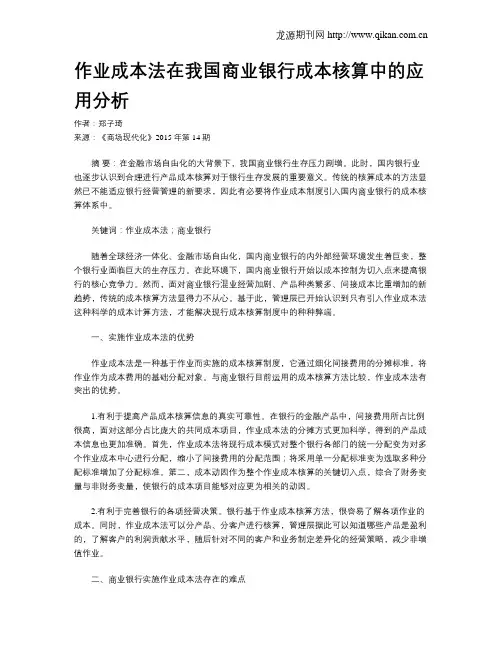
作业成本法在我国商业银行成本核算中的应用分析作者:郑子琦来源:《商场现代化》2015年第14期摘要:在金融市场自由化的大背景下,我国商业银行生存压力剧增。
此时,国内银行业也逐步认识到合理进行产品成本核算对于银行生存发展的重要意义。
传统的核算成本的方法显然已不能适应银行经营管理的新要求,因此有必要将作业成本制度引入国内商业银行的成本核算体系中。
关键词:作业成本法;商业银行随着全球经济一体化、金融市场自由化,国内商业银行的内外部经营环境发生着巨变,整个银行业面临巨大的生存压力。
在此环境下,国内商业银行开始以成本控制为切入点来提高银行的核心竞争力。
然而,面对商业银行混业经营加剧、产品种类繁多、间接成本比重增加的新趋势,传统的成本核算方法显得力不从心。
基于此,管理层已开始认识到只有引入作业成本法这种科学的成本计算方法,才能解决现行成本核算制度中的种种弊端。
一、实施作业成本法的优势作业成本法是一种基于作业而实施的成本核算制度,它通过细化间接费用的分摊标准,将作业作为成本费用的基础分配对象。
与商业银行目前运用的成本核算方法比较,作业成本法有突出的优势。
1.有利于提高产品成本核算信息的真实可靠性。
在银行的金融产品中,间接费用所占比例很高,面对这部分占比庞大的共同成本项目,作业成本法的分摊方式更加科学,得到的产品成本信息也更加准确。
首先,作业成本法将现行成本模式对整个银行各部门的统一分配变为对多个作业成本中心进行分配,缩小了间接费用的分配范围;将采用单一分配标准变为选取多种分配标准增加了分配标准。
第二,成本动因作为整个作业成本核算的关键切入点,综合了财务变量与非财务变量,使银行的成本项目能够对应更为相关的动因。
2.有利于完善银行的各项经营决策。
银行基于作业成本核算方法,很容易了解各项作业的成本。
同时,作业成本法可以分产品、分客户进行核算,管理层据此可以知道哪些产品是盈利的,了解客户的利润贡献水平,随后针对不同的客户和业务制定差异化的经营策略,减少非增值作业。
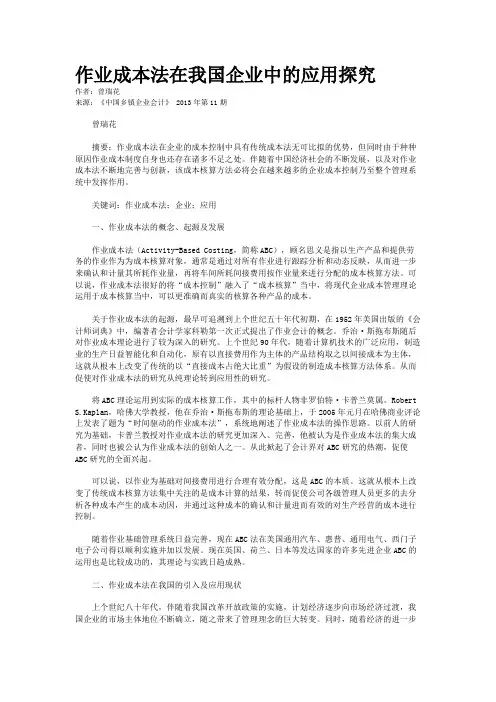
作业成本法在我国企业中的应用探究作者:曾瑞花来源:《中国乡镇企业会计》 2013年第11期曾瑞花摘要:作业成本法在企业的成本控制中具有传统成本法无可比拟的优势,但同时由于种种原因作业成本制度自身也还存在诸多不足之处。
伴随着中国经济社会的不断发展,以及对作业成本法不断地完善与创新,该成本核算方法必将会在越来越多的企业成本控制乃至整个管理系统中发挥作用。
关键词:作业成本法;企业;应用一、作业成本法的概念、起源及发展作业成本法(Activity-Based Costing,简称ABC),顾名思义是指以生产产品和提供劳务的作业作为为成本核算对象,通常是通过对所有作业进行跟踪分析和动态反映,从而进一步来确认和计量其所耗作业量,再将车间所耗间接费用按作业量来进行分配的成本核算方法。
可以说,作业成本法很好的将“成本控制”融入了“成本核算”当中,将现代企业成本管理理论运用于成本核算当中,可以更准确而真实的核算各种产品的成本。
关于作业成本法的起源,最早可追溯到上个世纪五十年代初期,在1952年美国出版的《会计师词典》中,编著者会计学家科勒第一次正式提出了作业会计的概念。
乔治·斯拖布斯随后对作业成本理论进行了较为深入的研究。
上个世纪90年代,随着计算机技术的广泛应用,制造业的生产日益智能化和自动化,原有以直接费用作为主体的产品结构取之以间接成本为主体,这就从根本上改变了传统的以“直接成本占绝大比重”为假设的制造成本核算方法体系。
从而促使对作业成本法的研究从纯理论转到应用性的研究。
将ABC理论运用到实际的成本核算工作,其中的标杆人物非罗伯特·卡普兰莫属。
Robert S.Kaplan,哈佛大学教授,他在乔治·斯拖布斯的理论基础上,于2005年元月在哈佛商业评论上发表了题为“时间驱动的作业成本法”,系统地阐述了作业成本法的操作思路。
以前人的研究为基础,卡普兰教授对作业成本法的研究更加深入、完善,他被认为是作业成本法的集大成者,同时也被公认为作业成本法的创始人之一。
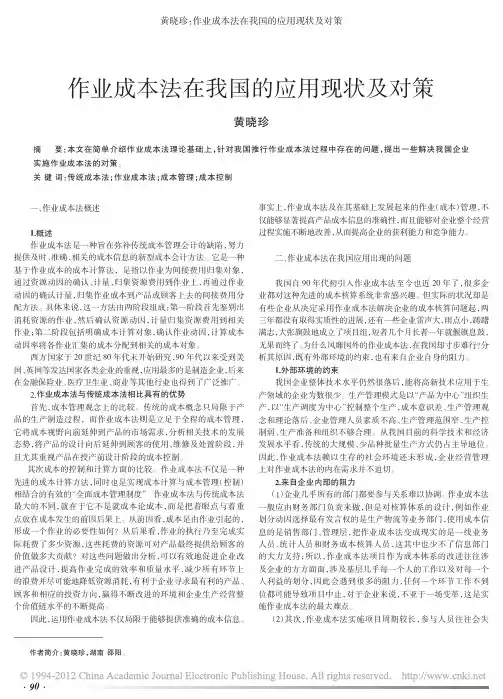
一、作业成本法概述1.概述作业成本法是一种旨在弥补传统成本管理会计的缺陷,努力提供及时、准确、相关的成本信息的新型成本会计方法。
它是一种基于作业成本的成本计算法,是指以作业为间接费用归集对象,通过资源动因的确认、计量,归集资源费用到作业上,再通过作业动因的确认计量,归集作业成本到产品或顾客上去的间接费用分配方法。
具体来说,这一方法由两阶段组成:第一阶段首先鉴别出消耗资源的作业,然后确认资源动因,计量归集资源费用到相关作业;第二阶段包括明确成本计算对象,确认作业动因,计算成本动因率将各作业汇集的成本分配到相关的成本对象。
西方国家于20世纪80年代末开始研究,90年代以来受到美国、英国等发达国家各类企业的重视,应用最多的是制造企业,后来在金融保险业、医疗卫生业、商业等其他行业也得到了广泛推广。
2.作业成本法与传统成本法相比具有的优势首先,成本管理观念上的比较。
传统的成本概念只局限于产品的生产制造过程,而作业成本法则是立足于全程的成本管理,它将成本视野向前延伸到产品的市场需求,分析相关技术的发展态势,将产品的设计向后延伸到顾客的使用、维修及处置阶段,并且尤其重视产品在投产前设计阶段的成本控制。
其次成本的控制和计算方面的比较。
作业成本法不仅是一种先进的成本计算方法,同时也是实现成本计算与成本管理(控制)相结合的有效的“全面成本管理制度”。
作业成本法与传统成本法最大的不同,就在于它不是就成本论成本,而是把着眼点与着重点放在成本发生的前因后果上。
从前因看,成本是由作业引起的,形成一个作业的必要性如何?从后果看,作业的执行乃至完成实际耗费了多少资源,这些耗费的资源可对产品最终提供给顾客的价值做多大贡献?对这些问题做出分析,可以有效地促进企业改进产品设计,提高作业完成的效率和质量水平,减少所有环节上的浪费并尽可能地降低资源消耗,有利于企业寻求最有利的产品、顾客和相应的投资方向,赢得不断改进的环境和企业生产经营整个价值链水平的不断提高。
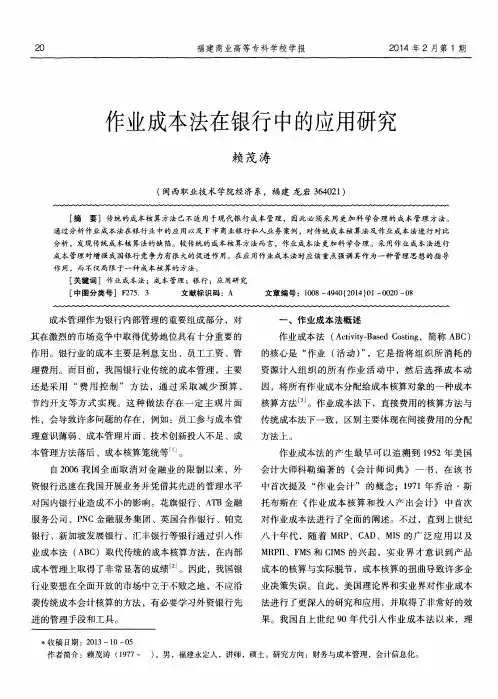
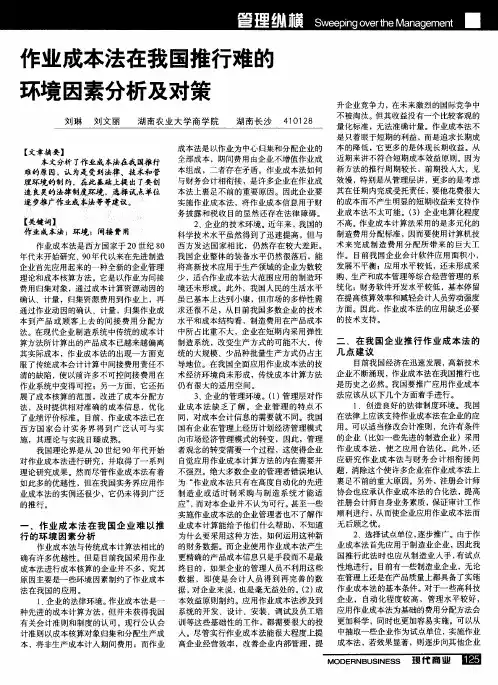
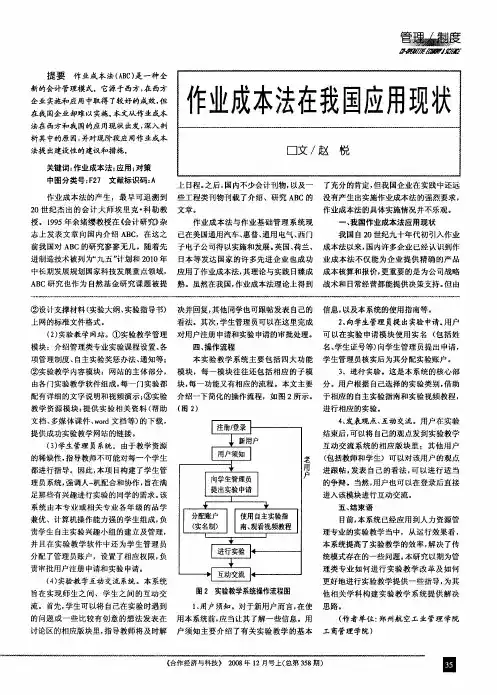
作业成本法应用中的问题及改进措施作业成本法是一种用于制造成本核算的方法,它将制造成本分为直接材料、直接人工和制造费用三个部分,并将制造费用按照制造过程中的不同环节进行分配。
虽然作业成本法在实践中得到广泛应用,但其应用过程中也存在一些问题。
本文将探讨作业成本法应用中的问题,并探讨改进措施。
问题一:制造费用难以均匀分配在实践中,制造费用的分配往往难以实现完全的精确均衡,这主要是因为不同的作业任务在执行过程中所需的制造费用并不相同。
由于制造费用的不均衡分配,精细化的成本核算难以实现,导致企业难以准确核算各个作业的成本。
改进措施:应该对制造费用进行不同程度的分配,根据不同的作业任务贴近实际的进行调整,实现费用的有效利用。
问题二:不适用于生产线连续生产情况由于作业成本法是基于作业的计算模式,它不能很好地适应连续流程的生产模式。
在生产线连续生产的情况下,产品的制造过程通常是流水线式进行的,而不是以不同的作业为基础。
因此,作业成本法可能并不适用于这样的生产模式,并可能导致成本核算错误。
对于生产线连续生产的情况,应该采用其他成本核算方法,如加权平均法或标准成本法。
这些方法更符合连续流程生产的实际情况,能够更准确地计算产品成本。
问题三:计算成本时间长在实践中,使用作业成本法进行成本核算的过程可能需要耗费大量的时间。
因为作业成本法需要对每个作业任务的成本进行详细的跟踪和记录,这需要工厂负责人和会计人员投入大量的时间和精力。
可以通过自动化和计算机技术来减少时间,如应用ERP系统,将成本核算自动化,并将数据存储在计算机中,通过计算机管理和处理成本核算,从而提高核算效率。
问题四:不适用于复杂的制造业在某些涉及到复杂工艺和制造流程的行业,例如飞机制造业和汽车制造业,作业成本法并不适用,因为这些行业的生产过程通常具有复杂性,难以进行逐一细分的成本核算。
总之,作业成本法在实践中被广泛应用。
但是,由于错误或不良应用而导致的问题也很多。
作业成本法在我国商业银行的应用研究【摘要】本文主要围绕作业成本法在我国商业银行的应用展开研究。
在阐述了研究背景、研究目的和研究意义。
接着在详细介绍了作业成本法的概述,并分析了我国商业银行作业成本法的现状。
结合具体案例,探讨了作业成本法在我国商业银行的应用情况。
对作业成本法的优势和局限性进行了评述,并展望了其在我国商业银行的发展前景。
在对研究进行总结,展望未来研究方向,并提出了结论的要点。
通过本文的研究,可以更全面地了解作业成本法在我国商业银行中的应用情况,为提升银行经营效率和降低成本提供参考。
【关键词】关键词:作业成本法、商业银行、应用研究、现状分析、优势、局限性、发展前景、研究总结、研究展望。
1. 引言1.1 研究背景作业成本法是一种管理会计方法,旨在帮助企业评估和控制生产和服务过程中的各项成本。
在当今激烈的市场竞争环境下,商业银行面临着诸多挑战,如如何提高效率、降低成本、增加竞争力等。
研究作业成本法在我国商业银行的应用具有重要意义。
在这样的背景下,研究我国商业银行如何应用作业成本法,对于提升商业银行的核心竞争力,降低经营风险,实现可持续发展具有积极的促进作用。
本文旨在深入探讨作业成本法在我国商业银行的应用研究,为商业银行的管理实践提供理论参考和实践指导。
1.2 研究目的作业成本法是一种管理会计方法,通过对银行各项业务的成本进行精细计算和分析,帮助银行领导层更好地了解业务成本结构,提高经营效率和管理水平。
本研究旨在探讨作业成本法在我国商业银行的应用情况,深入剖析其在实际操作中的作用和效果,为我国商业银行的管理实践提供一定的启示和建议。
具体研究目的包括:分析我国商业银行当前使用作业成本法的情况,了解其应用程度和效果;通过对作业成本法在我国商业银行的具体应用案例进行研究,探讨其实际操作过程中可能遇到的问题和解决方法;评估作业成本法在我国商业银行的优势和局限性,揭示其在不同场景下的应用价值和适用范围;展望作业成本法在我国商业银行的未来发展前景,为银行管理者提供决策参考,并对进一步研究作业成本法在我国商业银行中的应用提出建议和展望。
作业成本法应用中的问题及改进措施作业成本法(Activity-Based Costing, ABC)是指一种基于活动成本的计算方法,它充分考虑企业生产过程中各种活动的实际成本,通过合理分配成本,得出每一个产品的实际成本。
在企业的成本控制和成本优化中,使用作业成本法能够发现问题所在,帮助企业调整生产模式,从而提高效率和利润。
然而,作业成本法在使用过程中,也存在一些问题,需要进行改进。
问题一:选择计算业务活动在应用作业成本法时,需要确定计算的业务活动。
不同的业务活动计算方式不同,导致在使用时需要对不同业务活动进行分类。
如果分类不准确或分类过多,会导致成本计算出现偏差或过于复杂。
改进措施:对于计算业务活动,可以采用ABC树形图,以先宏观为主,了解整个生产过程及相关业务活动,然后细分到具体的环节活动。
通过细化精细管理效果来确保成本计算的准确性。
问题二:无法精确把握量化数据在实际运用过程中,作业成本法需要依赖于大量的数据。
但是,由于某些数据难以准确把握,如产品成本核算等,容易产生误差。
改进措施:在应用作业成本法过程中,可以采用预算控制方式,以及运用市场数据来对数据进行估算,客观地对成本信息进行分类和统计。
问题三:缺乏对数据的跟踪和监控一旦确定了业务活动的分类和计算方式,作业成本法就需要根据数据进行核算和统计。
但是,在实际运用过程中,数据跟踪和监控不够完善,容易出现数据丢失、数据错误等问题,导致计算不准确。
改进措施:加强对数据质量的监控,及时发现和纠正数据错误,建立完善的数据统计和跟踪平台。
问题四:成本数据没能产生决策帮助作业成本法的核心目的是对成本进行准确地核算,以便企业制定更好的战略决策。
但往往在企业内部的决策中,成本数据却没能够发挥应有的作用,不能成为决策依据。
改进措施:1)加强在应用过程中对成本数据的分析和评估,确保合理统计成本数据;2)完善与其他部门之间的协调和合作,以更好地配合战略决策的制定。
3)加强人员培训,提高责任意识,使之能够真正发挥作业成本法优势,帮助企业实现更好的效益。
本科毕业设计(论文)文献综述题目作业成本法在商业银行的应用探讨一、前言部分作业成本法不但能够追踪成本的发生,可以有效降低成本,还可以通过作业分析、作业管理改进业务流程,提高管理水平。
本篇综述主要探讨的是作业成本法在我国商业银行的应用,主要围绕作业成本法与传统成本核算体系下成本信息的比较、商业银行推行作业成本法盈利能力分析、作业成本法在商业银行的应用存在的问题、我国商业银行推行作业成本法的建议等方面展开。
(一)写作目的随着我国金融开放程度的提高, 各种金融机构的兴起和加入WTO 后外资银行的进入, 我商业银行面临着来自国内外的巨大竞争压力。
金融业竞争的进一步加剧, 促使商业银行必须通过加强内部管理来降低成本, 提高资产质量和盈利能力。
在这种背景下, 一种全新的成本管理方法——作业成本法( Activity Based Costing简称ABC) 越来越受到我国商业银行的注与推崇。
现阶段,随着商业银行存贷利差的日益缩小,传统业务的盈利空间逐渐被压缩,商业银行的竞争力更取决于各自业务流程中的成本和质量。
因此,在扩大市场份额的同时,商业银行应该关注成本的降低。
作业成本法不但能够追踪成本的发生,可以有效降低成本,还可以通过作业分析、作业管理改进业务流程,提高管理水平。
目前国内商业银行的成本管理存在着很大的缺陷,传统的成本管理方法已无法适应现代商业银行管理及未来发展,主要体现于对占总成本比例较大的间接费用的分摊不合理,在很大程度上扭曲了成本核算,无法反映银行内部各部门的运营效果。
积极引入作业成本法,可以大幅提高商业银行的管理水平和运营效率,对改善商业银行的成本控制、盈利分析、业绩评价和服务水平等方面都具有重要的现实意义。
(二)相关概念作业成本制度的产生,是包括新型的成本核算方法和成本管理思想、横跨成本会计和管理会计的会计学最新发展成果。
其最早可以追溯到20世纪杰出的会计大师美国人科勒(E.Kohler)教授。
本科毕业论文(设计) 外文原文 夕卜文题
目 ________________ Why Did ABC Fail at the Bank of China? 夕卜 文出处 《Bank Accounting & Finance》Public
Money&Manegement, 2006 (3) :39 — 42 外文作者 杰弗里•怀特 / 罗纳德W希尔顿 __________________ 原文: Why Did ABC Fail at the Bank of China? EXECUTIVE SUMMARY Few authors have explored the implementation of activity-based costi ng (ABC) in East Asia n compa ni es. This study inv estigates factors that led to the failure of an ABC implementation at a major Chinese financial institution — the Bank of China. Interviews with 18 employees at one branch revealed six factors that blocked the impleme ntati on: the lack of clear bus in ess purpose, a lack of educati on about ABC, poor model desig n, a lack of participa nts, in dividual and orga ni zati onal resista nee to cha nge, and the fact that few outsourcers were available. The study representsa real example of why ABC implementation might fail in an orga ni zati on. The key purpose of the Bank of China ' strategic plan is to generate,process, track, and close its leads in the Chinese financial market. As part of the plan, the bank aimed to introduce an activity-based costing (ABC) system across all of its regi ons in order to reduce costs and in crease man ageme nt con trol. The implementation failed, however, and the traditional costing system is still employed. We investigated factors that blocked the implementation of activity-based costing and man ageme nt (ABC/M) in one provisi onal ban k bran ch, the n ame and locati on of which are not disclosed for con fide ntiality reas ons. Our in terviews with 18 of the branch employees revealed six factors that blocked the impleme ntati on of ABC. These are: Lack of a clear business purpose about the implementation, 1. Lack of education about ABC, 2. Poor ABC model design, 3. Lack of participants, 4.Individual and organizational resistance to change, 5.Few outsourcers available. Although some or all of these factors have been mentioned in previous studies, our work is new in terms of its application to the bank sector in China, which allows us to contribute to the knowledge of ABC in practice. Today, Chinese banks are facing strong competition,especially from foreign banks that have entered the Chinese financial market. Those foreign banks, which had opened in Shanghai earlier have started to expand their business into Jiangsu and Zhejiang provinces. They grabbed a large number of giant clients from their Chinese counterparts, causing a decrease in bank loans in the provinces, according to a 2002 press release by the People s'Bank of China, Nanjing Branch in eastern Jiangsu province. To eradicate such problems and prevent the situation from getting worse, Chinese banks needed to apply more effective management methods and technologies to improve their competitive advantage. Furthermore,the government of the People ' s Republic of Chdiencaided to turn state-owned banks into publicly listed ones to enhance the banks '-csoenlftrollability and flexibility that help them react to market conditions in a timely and effective manner. As one of the big four state-owned banks, Bank of China Ltd. had started to restructure itself and tried to implement management accounting in order to manage its costs. The implementation of such management accounting techniques in China is difficult, however,
because of the varied economic, institutional, and cultural settings. An interview with the general manager of the branch revealed that it tried to implement ABC three years ago, but the effort was unsuccessful.The failure to implement ABC cost the organization money, and there is a need to reduce these costs by identifying and analyzing factors that blocked the ABC implementation. If those barriers cannot be resolved, this may continue to obstruct the application of new management accounting techniques and further influence the organization 's capabilities. Although most of the existing literature extols the benefits of ABC and, in particular, the benefits of ABC/M, few authors have explored its implementation in East Asian companies, especially financial institutions. ABC VS. TRADITIONAL COSTING SYSTEMS Before we describe the results of our study, let look a't tshe conflicting views about ABC. Ronald W. Hilton, among others, defined ABC as a two-stage model.1 In the first stage, overhead costs are allocated into different activity-based cost pools with respect to their classifications. In the second stage, using a series of cost driver-based rates, the pooled costs are allocated to product lines. Gary Cokins argued that, compared to the two-stage model, a traditional costing system is like a “ checkbook w”here one can read the total amount spent but can never know the purpose and results of each check. Traditional cost systems are always employee payroll related, which hinders a manager'asbility to judge and improve employees 'activities and performance. Furthermore, the payroll-related costs do not indicate the interaction and relationships between one activity and others or products and customer services. Managers will not be able to identify which events cause activity costs to vary. Based on managers'views, however, an organization a'ctsivity costs could be the most controllable part that managerscan influence. Nonetheless, without knowing the costs ' drivers, managers are virtuanlalyble to organize a company' s production costs efficiently. In contrast, ABC concentrateson activities involved in the work process that help managers operate a business or an organization. “ ABC/M is work-centric, whereas the general ledger (traditional costing system) is transaction-centric. ”3 Nonetheless, both systems have their points: The traditional cost system is easy and inexpensive to implement, but the information obtained could be too raw to be analyzed. ABC solves that problem but is expensive and very time-consuming. FACTORS LEADING TO THE SUCCESS OR FAILURE TO IMPLEMENT ABC Despite its growing popularity, a number of companies started to experience difficulties with ABC implementation that blocked them from taking it further. A series of factors has